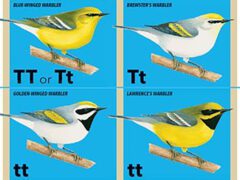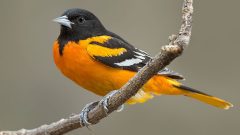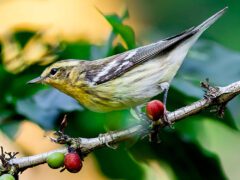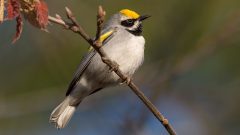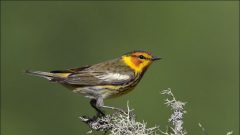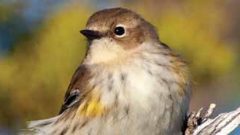Blue-winged Warbler Similar Species Comparison
Main SpeciesBlue-winged Warbler
Adult male
Small warbler with a small, pointed black bill. Adult males have two obvious wingbars and a black eyeline.
© Daniel Irons / Macaulay LibraryMaryland, September 03, 2017Adult female
Females are often paler than males with a grayer eyeline and a more olive crown, but some are not separable from males.
© Jay McGowan / Macaulay LibraryNew York, May 19, 2016Adult male
Song consists of a thin, high buzz followed by a trill; a beee-buzz as if the bird was inhaling and then exhaling.
© Eric Liner / Macaulay LibraryNew York, June 01, 2009Immature
Small songbird with a thin, pointed bill. Immature birds have a pinkish bill, yellow undertail coverts, and very thin (almost invisible) wingbars.
© Jeremy Collison / Macaulay LibraryNew York, August 04, 2016Adult male
Males are bright yellow below with a thin black eyeline.
© Luke Seitz / Macaulay LibraryNew York, May 16, 2018Female
Females pull off strips of bark from vines and other shrubs to build a cup-shapped nest.
© Timothy Barksdale / Macaulay LibraryTexas, April 27, 1997Adult male
Males are bright yellow below with white undertail coverts. The wings are steely blue-gray with 2 prominent wingbars. Note thin black eyeline.
© Rex Bartlett / Macaulay LibraryOntario, May 19, 2016Adult male
Picks insects off foliage often while hanging upside down. Note white undertail coverts.
© David M. Bell / Macaulay LibraryOntario, May 08, 2013Adult male
Males sing a beee-buzz from exposed perches; inhaling on the beee and exhaling on the buzz.
© Eric Liner / Macaulay LibraryNew York, June 01, 2009Adult
Often forages at the outer edges of branches where it takes insects from vegetation. Some individuals cannot be accurately sexed.
© Jay McGowan / Macaulay LibraryNew York, May 19, 2016Adult male
Found in areas with shrubby undergrowth.
© Elista Fisher / Macaulay LibraryWisconsin, May 09, 2017Female
Females nest on or near the ground and sit tight on the eggs for 11–12 days.
© Kevin Fraser / Macaulay LibrarySimilar SpeciesGolden-winged Warbler
Male
Male Golden-winged Warblers have a black (not yellow) throat and a yellow wing patch that Blue-winged Warblers lack.
© Luke Seitz / Macaulay LibraryNew York, May 19, 2018Similar SpeciesGolden-winged Warbler
Female
Female Golden-winged Warblers are whitish below (not yellow) and have a yellow wing patch that Blue-winged Warblers lack.
© Sylvain Messier / Macaulay LibraryQuebec, May 18, 2019Don't miss a thing! Join our email list
The Cornell Lab will send you updates about birds,
birding, and opportunities to help bird conservation.

















































